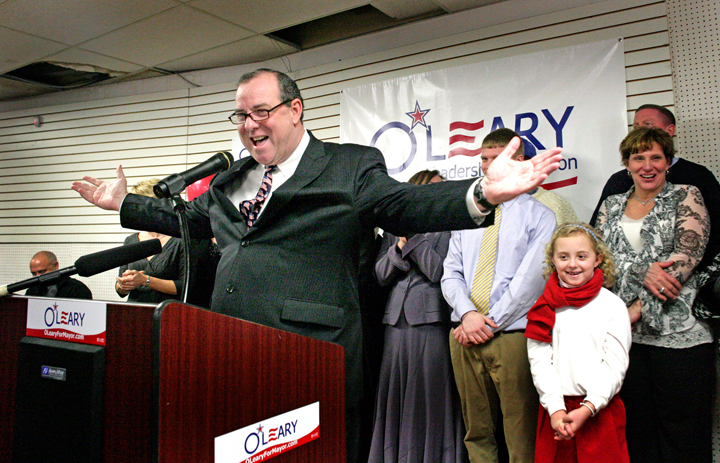East Main Street in Waterbury during Monday afternoon’s deluge of rain.
Story and Photographs by John Murray
Last night the Board of Aldermen in Waterbury voted unanimously to move a proposed $40 million greeway project forward with an initial investment of $1 million. As exciting as that project is, Waterbury Mayor Neil O’Leary is already zeroing in on a massive downtown revitalization project that he is presenting to state officials in mid-January. It involves five separate projects, all in downtown, that O’Leary believes will begin the transformation of downtown Waterbury.
“I can’t be specific at this point because we haven’t presented the ideas to state officicals yet,” O’Leary said. “But I can tell you that we are excited at the potential this has to revitalize downtown Waterbury.”
Three years ago Neil O’Leary wrapped up his mayoral announcement on a stage in a dilapidated storefront on East Main Street, and belted out “Downtown” by Petula Clark. If elected, O’Leary vowed to make downtown Waterbury the focus of his administration. Tens months later, after surviving a brutal campaign, O’Leary defeated five-term incumbent Mayor Michael Jarjura on election day. With victory in hand, O’Leary immediately focused on what was perceived as the single biggest economic development opportunity for the city in decades – the merger of Waterbury Hospital and St. Mary’s Hospital, and the construction of a new $500 million mega-hospital in downtown Waterbury.

O’Leary belting out “Downtown” by Petula Clark.
Former Connecticut Governor John Rowland called it a once in a lifetime opportunity for the city, and Mayor O’Leary and his economic development team worked tirelessly for ten months to make the merger a reality. O’Leary teamed city resources with state resources, and recruited Governor Dannel Malloy to help close the deal. At the finsih line the deal collapsed when Archbishop Henry Mansell nixed a proposal to set up a separate birthing center from the new hospital to circumvent Catholic doctrine regarding abortion. Both hospitals, LHP (who was investing the $500 million) and state and local officials were devastated.
“I thought we had it,” O’Leary said in the autumn of 2012. The mayor was disappointed at a ten-month investment of time in a project he undertsood to have already been vetted by the Archbishop, but he quickly turned his attention to trying to get Post University to expand its operation into the empty Soverign Bank building, and possibly create student housing in downtown.
O’Leary again worked closely with state officlas and Governor Malloy on the Post University project, but when Post declined to invest millions of it’s own capital (getting it’s skin in the game), another downtown project unravelled.
After winning re-election in November 2013, O’Leary vowed the next two years of his administration were going to be on downtown, this time with results. And during an interview on January 2nd, 2014, Mayor O’Leary said his team was in the final stage of putting together a five-project proposal to present to the Connecticut Department of Economic Development in mid-January to seek state funding for a variety of downtown revitalization projects.
“Governor Malloy has been very supportive of our efforts to revitalize Waterbury,” O’Leary said. “He was onboard with the hospital merger, he was onboard with the Post project, and when neither worked out, he encouraged us to come up with projects he could support. We believe we have done that.”
O’Leary declined to provide details of any of the five projects, but said they were all “new”, and would compliment one another. O’Leary said he has been working with RBA, a world class urban design company from NYC, to help develop a vision for downtown Waterbury.
“I’m not an urban planner, and no one who has ever sat in the mayor’s chair has been an urban planner,” O’Leary said. “After attending an urban design conference in Kentucky a year ago I realized urban design is a science unto itself, and we need experts to help move the city into the future.”
RBA had already been hired to design the Greenway in the South End of Waterbury, and O’Leary had the foresight to extend their contract into the next phase of the greenway, which triggered a $40 million dollar TIGER grant proposal that brought the greenway into downtown Waterbury, and created a 19-acre park along the Naugatuck River. Delighted at the concepts and visions from RBA, O’Leary asked them to extend their vision onto Bank Street, East Main Street, the Green, and South Main.
The proposal that the city and RBA is cobbling together now to present to state officials ties the greenway project and five separate projects into one a master plan for downtown revitalization. To expedite planning and organization, O’Leary recruited Kevin Del Gobbo from his post as executive director of the Waterbury Development Corporation, and has him set up inside City Hall as his senior advisor.
“We’ve spent a lot of time with RBA walking and driving and exploring downtown Waterbury,” O’Leary said. “We’ve involved stakeholders in the process – property owners, the corporate community, COG (Council of Governemnets of the Central Naugatuck Valley), and we’ve tried to get feedback from everyone. We now have what we think is an excellent plan to move downtown Waterbury forward.”
O’Leary said he hoped to present the proposal to state officials in the coming weeks, and after it is vetted by the state, the specifics of the plan can be released to the public.

